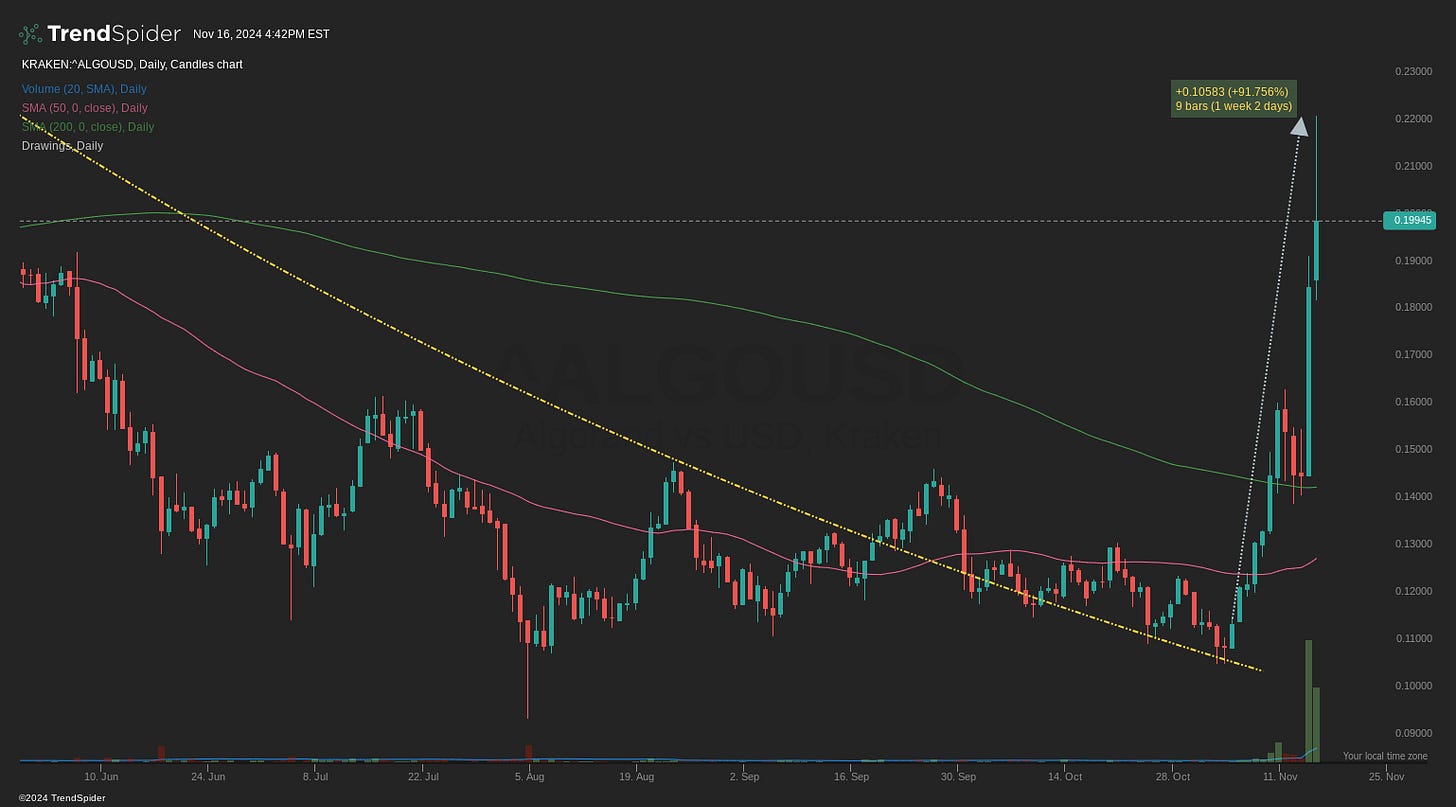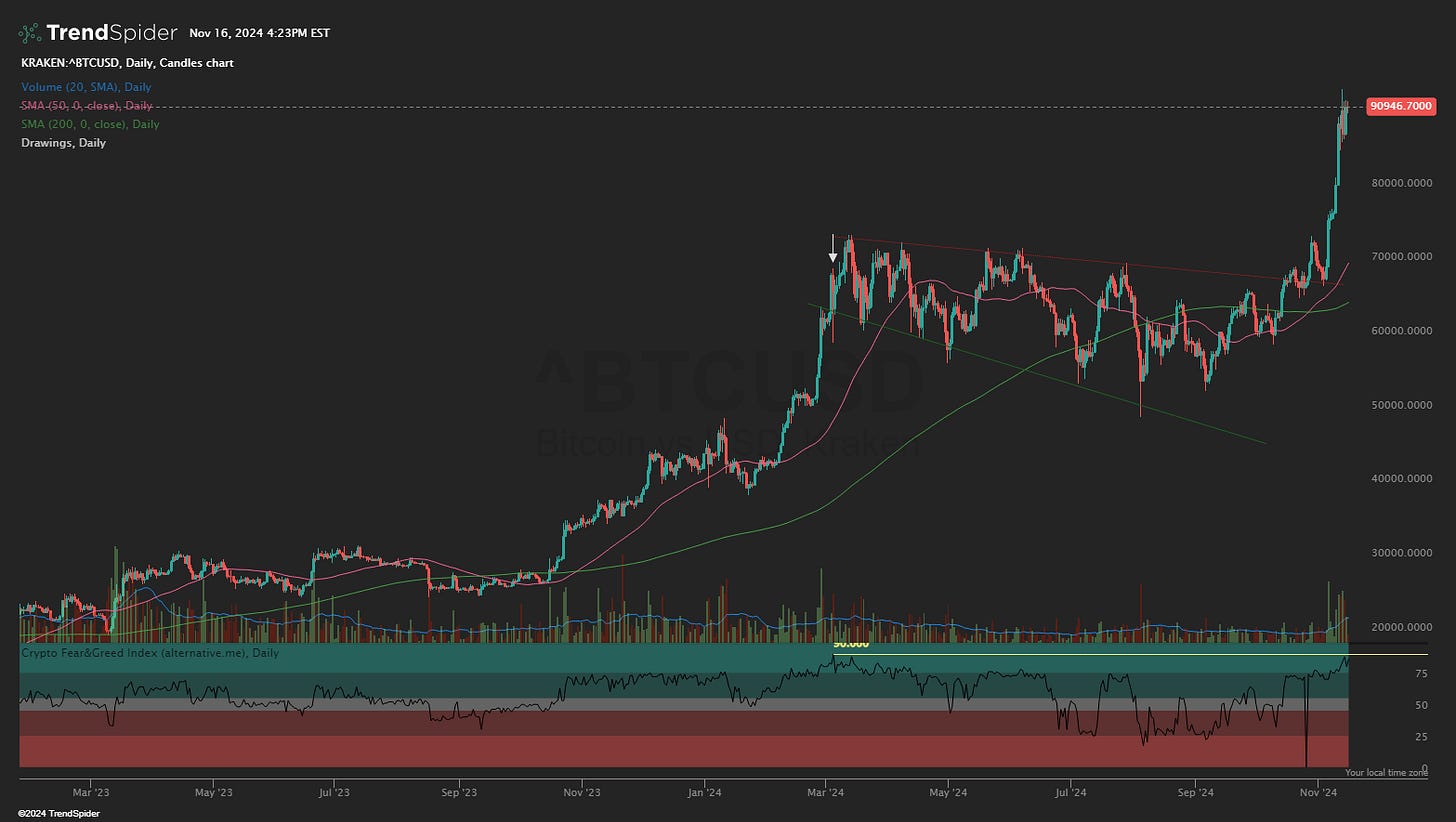Peanuts, Poocoins, and A Soft Landing!
Look at me. Look at me. Memes are the captain now.
I suspect many of you have already heard the sad story of Peanut the Squirrel. Here’s a great piece from El Gato Malo on the debacle for those who have no idea what I’m referring to:
What you may not know is Peanut the Squirrel has been immortalized through the “Peanut The Squirrel” PNUT token on the Solana Blockchain. In a matter of about a week, PNUT has gone from 3 cents per coin to nearly $2.50 at its peak on Wednesday:

PNUT is currently trading at a $1.7 billion market cap - it has the 59th ranked market cap in all of crypto. Ahead of things like MakerDAO, Lido Finance, Zcash and Compound. Incredibly, $1.7 billion doesn’t even put PNUT in the top 5 memecoins ranked by capitalization. Dogecoin, Shiba, Pepe, Bonk, and “dogwifhat” are all more vALUaBLe memes according to the market:
As I detailed in my Grayscale Solana Trust $GSOL piece for Seeking Alpha during the week (free link here), the performances of things like Bitcoin, Ethereum, and Solana over the last month - while impressive - are simply dwarfed by the 100% return of Artemis’ memecoin index:
So even as Bitcoin prices hit new all time highs in spite of monthly active users at multi-year lows, the ‘killer app’ of the crypto world continues to be printing money with memes and narratives. I’m pretty sure I’ve made this point before, but I’ll make it again; as much as I would like to see more validation of the tech in the real world, it’s very difficult to argue that this industry should be taken seriously when a cryptocurrency that was created as a joke has a higher market capitalization than equity in Ford F 0.00%↑, Constellation Brands STZ 0.00%↑, Occidental Petroleum OXY 0.00%↑, and All State ALL 0.00%↑.
Before the election earlier this month, I was asked to provide Seeking Alpha readers with my thoughts on what I felt could be a potential post-election impact for crypto. Perhaps not a surprise to anyone here, or there for that matter, I theorized that a Trump win would be good for crypto and specifically mentioned potential out-performance in assets like Ripple, Algorand, and Binance. The logic? The lead developers of these chains have come under heavy scrutiny during the Biden Administration’s war against bank insurgents.
Of those three assets, I hold just one. And as fate would have it, that asset has rallied almost 100% since election night. A meme coin after my own heart? Perhaps so because as far as I can tell, there is virtually no fundamental reason for such an enormous rally in ALGO aside from Gary Gensler seemingly leaving his post soon. And that’s not a ‘nothing-burger.’ I look forward to that day the way a child awaits Christmas. But the reality on Algorand the chain is still not a great one.
TVL has generally been in decline for two years and the stablecoin footprint trend has been horrendous having fallen by 90% from $430 million in May 2022 down to $43 million today. Will a new regulatory regime in the United States change this trend? Time will tell. In the meantime, we chase memes and narratives. I actually do still think Bitcoin will hit $100k in this cycle and likely before the end of this year, if not this month. But from there? I have no idea.
I see a crypto fear and greed index at 85. When it gets to 90, we’re not far from a top if the March rally is any guide. With traditional financial products like spot ETFs playing such an important role in this rally, I question the viability of a sustainable “altcoin season” since capital that would have otherwise flown from BTC to alts on chain is now sitting in iShares Bitcoin Trust IBIT 0.00%↑ instead. But I have to admit, even though I think we’ve clearly jumped the shark in the cryptocurrency market, I’m not fighting the tape on this.
As Ned Davis would say; would you rather be right, or make money? Of course… there’s always the possibility of an outside catalyst that changes things on a dime…
A Soft Landing!
What's caused all the cheeriness is growing confidence that this business cycle won't end with a recession. Instead, the economy will make a "soft landing." Translation: the Federal Reserve will slow economic growth enough to ease inflation without triggering a slump. That's bliss. Sound too good to be true? Plenty of skeptics -- me included -- think so. - Robert J. Samuelson
Any guesses as to when those words were published in the Washington Post? Sound like it could have been written yesterday? Turns out Robert J. Samuelson penned that paragraph in June 1989. It’s from an opinion piece called “A Soft Landing?” Take out the dates and this article that was previously published and distributed on paper reads like something that could be distributed today through any contrarian financial Substack publication. We’ve heard Jerome Powell’s control of the economy isn’t much different from a pilot safely grounding a commercial flight for Delta DAL 0.00%↑. This too, has been seen before:
Modern economics makes itself intelligible by adopting everyday analogies. If inflation worsens, we say the economy is "overheating." If the Federal Reserve raises interest rates, it's "applying the brakes." If it cuts rates, it's "stepping on the gas." The metaphor of the moment is "soft landing." The economy slows enough to avoid higher inflation but not so much that it suffers a "hard landing" (a recession). It's an enticing vision--which may or may not come true. - Robert J. Samuelson, June 2000
Samuelson’s skepticism of the soft landing concept made a triumphant return in June 2000 with yet another Washington Post opinion piece titled “A Soft Landing?” In it, he chides the financial press for giving credence to such assertions because Alan Greenspan isn’t like a pilot and the economy isn’t like a plane. True indeed.
In each case, the timing of the articles was fairly prescient. See my crudely drawn arrows indicating dates of publication above. What about the GFC-era financial meltdown? Samuelson couldn’t possibly have predicted the “soft landing” pronouncements would fail to live up to expectations then too… could he? Well, at least not for the Washington Post. Here’s his commentary via Newsweek in January 2006:
The sunny predictions suggest two familiar economic catch-phrases: "soft landing" and "Goldilocks economy." The Federal Reserve stops raising interest rates before it causes a recession; that's the soft landing. Economic growth is then fast enough to keep unemployment low and not so fast as to trigger higher inflation; that's the Goldilocks economy (like Goldilocks's porridge, the economy is not too hot or too cold). Could anything darken the outlook and, coincidentally, feed journalism's appetite for misfortune? Well, yes. - Robert J. Samuelson, January 2006
While Samuelson was two years early on this one, he did list 5 possible bearish catalysts that could trigger an invalidation of the “soft landing” hypothesis:
Housing goes bust
The dollar “crashes”
General Motors GM 0.00%↑ files for bankruptcy
Oil jumps to $85 a barrel
The "yield curve" of interest rates "inverts”
Every single one of which ended up actually happening if you count the dollar index falling from 91 to 72 between January 2006 and March 2008 as a “crash.” I point all of this out not to say that the now-retired Samuelson should drop another well-timed gem. Rather, to point out that the very notion that investors should be anticipating a “soft landing” is akin to Charlie Brown trying to kick a football that Lucy keeps pulling away. And we’re clearly here again with assertions that our expert pilots at the Fed have orchestrated a “soft landing.”
Why do we keep doing this?
The cynic would perhaps say the legacy media apparatus is intentionally used as a propaganda instrument by our corporate overlords to get mom and pop investors buying stocks all the way to the top while insiders pull an Irish goodbye out the back door.
The optimist would perhaps say it’ll be ‘different this time’ and to trust the heavily-cooked, self-graded homework that is government economic numbers - even when well over 1 million jobs are revised away in a single year after the headlines have already juiced equity markets higher.
The realist would perhaps say it doesn’t matter what the reason is, just don’t trade markets like a squid.
There are plenty ‘of us’ Fed pilot skeptics here on the internet and we’ve all been very early. But as Samuelson proved not once, but three times, between 1989 and 2006, being early may not be the same as being wrong - certainly not in the land of the legalized Ponzi market that requires more tokens in perpetuity to maintain the illusion of unrealized nominal gains.
Fun fact: Squirrels dig holes for the purpose of pretending to hide nuts to fake out would-be thieves. Traders might call this ‘market spoofing.’
Disclosure: I’m not an investment advisor. I merely share what I do and why I do it. You shouldn’t take anything I say as investment advice and always do your own research when making investment decisions. Cryptocurrencies, tokens, STONKs, and digital trinkets could all go to zero. Nobody cares about your money as much as you do; that includes your hired help, TBTF analysts, or any newsletter author regardless of bull/bear bias. Learn these markets. Form your own opinion. And trust yourself over any self-proclaimed gurus or experts.












hysterical, great piece Mike, when I see the name of some of these meme coins 'dogwifhat'. it it full lol. I didn't even know these things really traded. But just based on the sense of humour of it all it makes me want to play in meme coins. and like Ned Davies said 'would you rather be right or make money?' hysterical